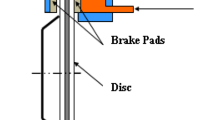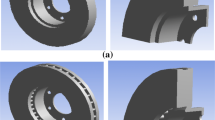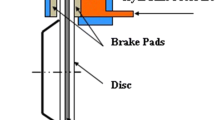Abstract
The braking phenomenon is an aspect of vehicle stopping performance where in kinetic energy due to speed of the vehicle is transformed into thermal energy produced by the brake disc and its pads. The heat must then be dissipated into the surrounding structure and into air flow around the brake system. The thermal friction field during the braking phase between the disc and the brake pads can lead to excessive temperatures. In our work, we presented numerical modeling using ANSYS software adapted in the finite element method, to follow the evolution of the global temperatures for the two types of brake discs, full and ventilated discs, during braking scenario. Also, numerical simulation of the transient thermal analysis and the static structural were performed here sequentially, with coupled thermo-structural method. Numerical procedure of calculation relies on important steps such that the Computational Fluid Dynamics (CFD) and thermal analysis have been well illustrated in 3D, showing the effects of heat distribution over the brake disc. This CFD analysis helped us in the calculation of the values of the thermal coefficients (h) that have been exploited in 3D transient evolution of the brake disc temperatures. Three different brake disc materials were tested and comparative analysis of the results was conducted in order, to derive the one with the best thermal behavior. Finally, the resolution of the coupled thermomechanical model allows us to visualize other important results of this research such as the deformations and the equivalent stresses of von Mises of the disc, as well as the contact pressure of the brake pads. Following our analysis and results we draw from it, we derive several conclusions. The choice allowed us to deliver the rotor design excellence to ensure and guarantee the good braking performance of the vehicles.







































Similar content being viewed by others
Abbreviations
- a :
-
Vehicle deceleration (m/s2)
- A c :
-
Surface area of the braking pad (m2)
- A d :
-
Disc surface swept by a brake pad (m2)
- [B]:
-
Kinematic matrix
- C p :
-
Specific heat (J/kg °C)
- [D]:
-
Material property matrix
- d :
-
Displacement vector (m)
- E :
-
Young’s modulus (MPa)
- F :
-
Force vector (N)
- F disc :
-
Rotor force (N)
- g :
-
Gravitational acceleration (m/s2)
- h :
-
Heat transfer coefficient (W/m2 °C)
- k :
-
Thermal conductivity (W/m °C)
- [K]:
-
Stiffness matrix
- m :
-
Vehicle mass (kg)
- p :
-
Pressure (Pa)
- P :
-
Pressure for a single pad (MPa)
- q 0 :
-
Heat flux entering the disk (W)
- q x :
-
Conduction heat flux in x-direction (W/m2)
- q y :
-
Conduction heat flux in y-direction (W/m2)
- q z :
-
Conduction heat flux in z-direction (W/m2)
- Q :
-
Internal heat generation rate per unit volume (W/m3)
- R rotor :
-
Effective rotor radius (m)
- R tire :
-
Tire radius (m)
- S m :
-
Source term (kg)
- t :
-
Time (s)
- T :
-
Temperature (°C)
- T 1 :
-
Specified surface temperature (°C)
- T s :
-
Unknown surface temperature (°C)
- t stop :
-
Time to stop (s)
- T e :
-
Convective exchange temperature (°C)
- v :
-
Velocity vector (m/s)
- v 0 :
-
Initial speed of the vehicle (m/s)
- v r :
-
Relative velocity vector (m/s)
- x :
-
Space variable in x-direction (m)
- y :
-
Space variable in x-direction (m)
- z :
-
Space variable in x-direction (m)
- z :
-
Braking effectiveness
- α :
-
Thermal expansion coefficient (1/°C)
- ε:
-
Strain vector
- ε p :
-
Factor load distribution on the disk surface
- µ :
-
Coefficient of friction disc/pad
- ρ :
-
Mass density (kg/m3)
- σ:
-
Stress vector (N/m2)
- τ :
-
Stress tensor (Pa)
- υ :
-
Poisson coefficient
- ϕ :
-
Rate distribution of the braking forces between the front and rear axle
- ω :
-
Angular velocity (rad/s)
- Ω:
-
Angular velocity vector (rad/s)
- CFD:
-
Computational fluid dynamic
- FG:
-
Gray cast iron
- HTC:
-
Heat transfer coefficients
- me :
-
Mechanical index
- th :
-
Thermal index
References
Abu Bakar AR (2005) Modelling and simulation of disc brake contact analysis and squeal.” PhD Thesis, Department of Engineering, University of Liverpool, 2005
Abu Bakar AR, Ouyang H, Khai LC, Abdullah MS (2010) Thermal analysis of a disc brake model considering a real brake pad surface and wear. Int. J Veh Struct Syst 2(1):20–27
Adamowicz A, Grześ P (2012) Convective cooling of a disc brake during single braking. Acta Mechanica et Automatica 6(2):5–10
Belhocine A (2015) Numerical investigation of a three-dimensional disc-pad model with and without thermal effects. Therm Sci 19(6):2195–2204
Belhocine A, Bouchetara M (2012a) Thermomechanical modeling of dry contact in automotive disc brake. Int J Therm Sci 60:161–170
Belhocine A, Bouchetara M (2012b) Thermal behavior of full and ventilated disc brakes of vehicles. J Mech Sci Technol 26(11):3643–3652
Belhocine A, Ghazaly NM (2016) Effects of Young’s modulus on disc brake squeal using finite element analysis. Int J Acoust Vib 31(3):292300
Belhocine A, Wan Omar WZ (2018) Predictive modeling and simulation of the structural contact problems between the brake pads and rotor in frictional sliding contact. Int J Interact Des Manuf 12(1):63–80
Belhocine A, Abu Bakar AR, Abdullah OI (2015) Structural and contact analysis of disc brake assembly during single stop braking event. Trans Indian Inst Met 68(3):403–410
Botkin ME (2000) Modelling and optimal design of a carbon fibre reinforced composite automotive roof. Eng Comput 16(1):16–23
Coudeyras N (2009) Non-linear analysis of multiple instabilities to the rubbing interfaces: application to the squealing of brake, PhD Thesis, Central school of Lyon-speciality: mechanics, December
Gotowicki PF, Nigrelli V, Mariotti GV, Aleksendric D, Duboka C (2005) Numerical and experimental analysis of a pegs-wing ventilated disk brake rotor with pads and cylinders. In: 10th EAEC Eur. Automot. Cong.–Paper EAEC05YUAS04–P5, June 2005
Huajiang O, Yuanxian G, Haitian Y (2004) A dynamic model for a disc excited by vertically misaligned, rotating, frictional sliders. Acta Mech Sin 20(4):418–442
Ishak MR, Abu Bakar AR, Belhocine A, Taib JM, Wan Omar WZ (2018) Brake torque analysis of fully mechanical parking brake system: theoretical and experimental approach. Ingenieria Investigacion y Tecnologia 19(1):37–49
Khalid MK, Mansor MR, Abdul Kudus SI, Tahir MM, Hassan MZ (2011) Performance investigation of the UTeM eco-car disc brake. Syst Int JEng Technol 11(6):1–6
Kothawade S, Patankar A, Kulkarni R, Ingale S (2016) Determination of heat transfer coefficient of brake rotor disc using CFD simulation. Int J Mech Eng Technol (IJMET) 7(3):276–284
Limpert R (1999) Brake design and safety, 2nd edn. Society of Automotive Engineering Inc., Warrendale, pp 137–144
Liu J, Ke LL, Wang YS (2019) Frictionally excited thermoelastic dynamic instability of functionally graded materials. Acta Mech Sin 35(1):99–111
Mackin TJ, Noe SC, Ball KJ, Bedell BC, Bim-Merle DP, Bingaman MC, Bomleny DM, Chemlir GJ, Clayton DB, Evans HA (2002) Thermal cracking in disc brakes. Eng Fail Anal 9:63–76
Oder G, Reibenschuh M, Lerher T, Šraml M, Šamec B, Potrč I (2009) Thermal and stress analysis of brake discs in railway vehicles. Adv Eng 3(1) (ISSN 1846-5900)
Palmer E, Mishra R, Fieldhouse JD (2009) An optimization study of a multiple row pin vented brake disc to promote brake cooling using computational fluid dynamics, Proc. Institution of Mech. Engineers, Part D, Journal of Automobile Engineering, 223(7): 865–875, 2009
Reimpel J (1998) Braking technology. Vogel Verlag, Würzburg
Stephens A (2006) Aerodynamic cooling of automotive disc brakes. Masters thesis. School of Aerospace, Mechanical & Manufacturing Engineering, RMIT University, March 2006
Tang J, Bryant D, Qi H (2014) Coupled CFD and FE thermal mechanical simulation of disc brake. In: Proc. Eurobrake Conference, Lille, France, 2014
Zhang J, Xia C (2012) Research of the transient temperature field and friction properties on disc brakes. In: Proceedings of the 2012 2nd international conference on computer and information application (ICCIA 2012), pp 201–204, 2012
Author information
Authors and Affiliations
Corresponding author
Ethics declarations
Conflict of interest
The authors declare that there is no conflict of interest.
Additional information
Publisher's Note
Springer Nature remains neutral with regard to jurisdictional claims in published maps and institutional affiliations.
Rights and permissions
About this article
Cite this article
Belhocine, A., Afzal, A. Finite element modeling of thermomechanical problems under the vehicle braking process. Multiscale and Multidiscip. Model. Exp. and Des. 3, 53–76 (2020). https://doi.org/10.1007/s41939-019-00059-w
Received:
Accepted:
Published:
Issue Date:
DOI: https://doi.org/10.1007/s41939-019-00059-w




